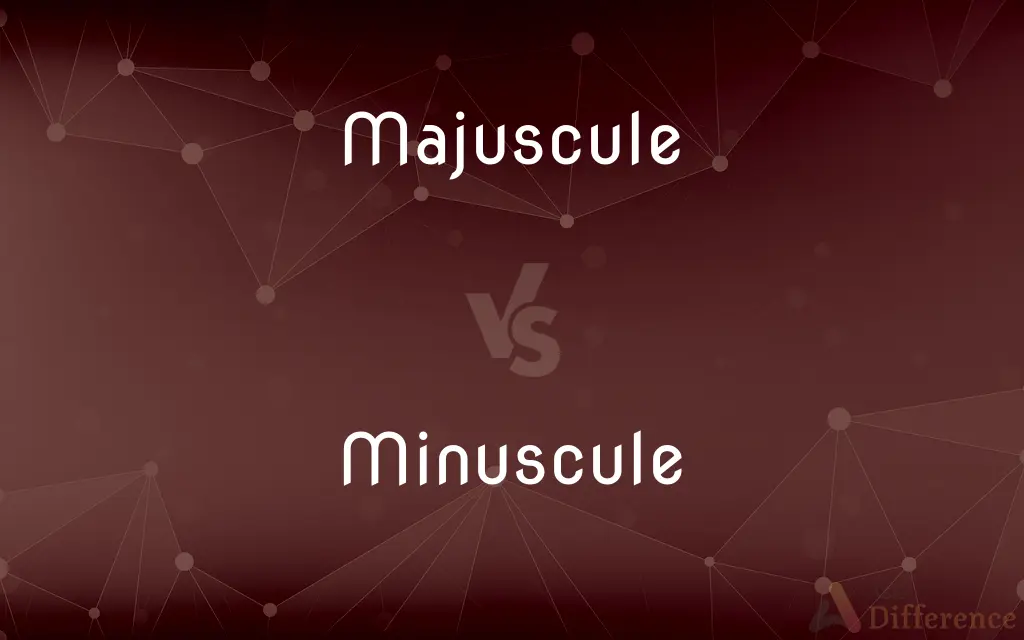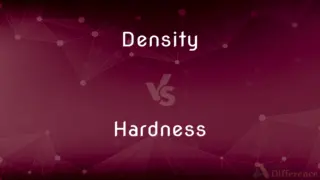Majuscule vs. Minuscule — What's the Difference?
By Urooj Arif & Fiza Rafique — Updated on April 16, 2024
Majuscule refers to uppercase letters used to start sentences and proper nouns, whereas minuscule denotes lowercase letters used for general text.

Difference Between Majuscule and Minuscule
Table of Contents
ADVERTISEMENT
Key Differences
Majuscule letters, also known as uppercase or capital letters, are primarily used for emphasizing particular words or to start sentences, while minuscule letters, often referred to as lowercase, are more commonly used throughout texts for standard writing and readability.
In typography, majuscule characters are often used for headers, titles, or to denote importance and formality, whereas minuscule characters provide a more subdued and continuous reading flow in longer texts such as books or articles.
Historically, the distinction between majuscule and minuscule letters emerged as a way to streamline the writing process and enhance script readability, with minuscule letters evolving to support faster handwriting.
In terms of visual design, majuscules tend to have a more uniform and block-like appearance, making them ideal for signs and posters, while minuscules often have varying shapes and extend above and below the baseline, aiding in distinguishing different letters more easily.
From a usage perspective in digital contexts, majuscules can signify shouting or emphasis when used excessively in texts or emails, whereas minuscules are the standard for digital communication, reflecting a conversational tone.
ADVERTISEMENT
Comparison Chart
Usage in Sentences
Start of sentences and proper nouns
Standard text throughout sentences
Typography Application
Titles, headers, signs
Body text in books, articles
Historical Development
Used in ancient scripts for formality and clarity
Evolved for faster, more readable handwriting
Visual Appearance
Uniform, block-like shapes
Varied shapes, extends above and below baseline
Implication in Digital Use
Can imply shouting or strong emphasis
Standard, conversational tone
Compare with Definitions
Majuscule
In manuscripts, majuscules were used for decorative initials.
Medieval texts often begin with ornate majuscules.
Minuscule
In handwriting, minuscules are quicker to write.
His notes were filled with rapid, scribbled minuscules.
Majuscule
A majuscule is an uppercase letter used at the beginning of sentences.
The book starts with the letter A.
Minuscule
A minuscule is a lowercase letter used in general text.
All the letters in this sentence are minuscules.
Majuscule
Majuscules are often used for acronyms.
NASA stands for the National Aeronautics and Space Administration.
Minuscule
Minuscules are essential for correct grammar.
She knows the importance of using proper case.
Majuscule
Majuscules are prominent in legal documents to denote importance.
The contract clauses were highlighted in majuscule.
Minuscule
Books are predominantly written in minuscule to aid readability.
The novel was easy to read thanks to its clear minuscules.
Majuscule
Advertising often utilizes majuscules for impact.
SALE TODAY ONLY – all letters are capitalized.
Minuscule
Minuscules help in distinguishing between common and proper nouns.
The river (common noun) and the Amazon River (proper noun).
Majuscule
A capital letter; especially, one used in ancient manuscripts. See Majusculæ.
Minuscule
Extremely small; tiny
A minuscule fragment of DNA
Majuscule
A large letter, either capital or uncial, used in writing or printing.
Minuscule
Of or in lower-case letters, as distinct from capitals or uncials.
Majuscule
A capital letter, especially one used in ancient manuscripts.
Minuscule
Minuscule script
The humanistic hands of the 15th century were based on the Carolingian minuscule
Majuscule
One of the large alphabetic characters used as the first letter in writing or printing proper names and sometimes for emphasis;
Printers once kept the type for capitals and for small letters in separate cases; capitals were kept in the upper half of the type case and so became known as upper-case letters
Minuscule
Very small; tiny.
Majuscule
Of or relating to a style of writing characterized by somewhat rounded capital letters; 4th to 8th centuries
Minuscule
Of, relating to, or written in minuscule.
Majuscule
Uppercase;
Capital A
Great A
Many medieval manuscripts are in majuscule script
Minuscule
A small cursive script developed from uncial between the seventh and ninth centuries and used in medieval manuscripts.
Minuscule
A letter written in minuscule.
Minuscule
A lowercase letter.
Minuscule
A lowercase letter.
Minuscule
Either of the two medieval handwriting styles minuscule cursive and Caroline minuscule.
Minuscule
A letter in these styles.
Minuscule
Written in minuscules, lowercase.
Minuscule
Written in minuscule handwriting style.
Minuscule
Very small; tiny.
A minuscule dot
Minuscule
Any very small, minute object.
Minuscule
A small Roman letter which is neither capital nor uncial; a manuscript written in such letters.
Minuscule
Of or relating to a minuscule{2} or of a script written in minuscules{2}; of the size and style of minuscules{2}; written in minuscules{2}; minuscular.
These minuscule letters are cursive forms of the earlier uncials.
Minuscule
The characters that were once kept in bottom half of a compositor's type case
Minuscule
A small cursive script developed from uncial between the 7th and 9th centuries and used in medieval manuscripts
Minuscule
Of or relating to a small cursive script developed from uncial; 7th to 9th centuries
Minuscule
Lowercase;
Little a
Small a
E.e.cummings's poetry is written all in minuscule letters
Minuscule
Very small;
A minuscule kitchen
A minuscule amount of rain fell
Common Curiosities
Where did the terms majuscule and minuscule originate?
The terms originated from Latin, with 'majuscule' derived from 'majuscula', meaning 'somewhat larger', and 'minuscule' from 'minuscula', meaning 'somewhat smaller'.
What is a minuscule?
A minuscule is a lowercase letter used for the majority of text in writing.
How do minuscules improve readability?
Minuscules vary in shape and height, which helps differentiate letters and make continuous text easier to read.
What is a majuscule?
A majuscule is an uppercase letter, typically used at the beginning of sentences and names.
Why are majuscules important?
Majuscules highlight the beginning of sentences and proper nouns, indicating importance or formal titles.
Can using majuscules impact the tone of digital communication?
Yes, excessive use of majuscules can be interpreted as shouting or strong emphasis in digital communication.
Are minuscules used in all types of writing?
Yes, minuscules are standard in most forms of writing, except where emphasis or formal distinction is needed.
Do majuscules and minuscules have different typographical rules?
Yes, typographical rules vary, with majuscules often used for headings and titles and minuscules for body text.
What is the historical significance of majuscules in manuscripts?
In manuscripts, majuscules served both decorative and practical purposes, making important texts stand out.
How does the use of majuscules and minuscules affect document design?
Majuscules can make documents appear more formal or urgent, while minuscules contribute to aesthetic and readability.
Share Your Discovery

Previous Comparison
Density vs. Hardness
Next Comparison
Drunk vs. DrunkardAuthor Spotlight
Written by
Urooj ArifUrooj is a skilled content writer at Ask Difference, known for her exceptional ability to simplify complex topics into engaging and informative content. With a passion for research and a flair for clear, concise writing, she consistently delivers articles that resonate with our diverse audience.
Co-written by
Fiza RafiqueFiza Rafique is a skilled content writer at AskDifference.com, where she meticulously refines and enhances written pieces. Drawing from her vast editorial expertise, Fiza ensures clarity, accuracy, and precision in every article. Passionate about language, she continually seeks to elevate the quality of content for readers worldwide.













































